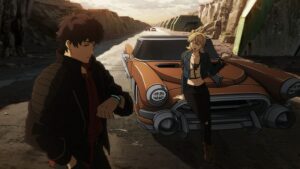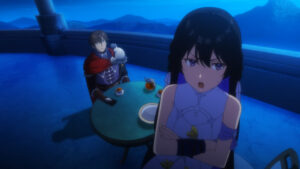Wooper: It’s just me this time, I’m afraid, unless another writer edits their seasonal musings into this post from the future. I was fairly pleased with what I watched over the past two weeks, though, so my usual negativity should be at a minimum here. The third volume of Star Wars Visions has gotten the brunt of it thus far, but I’m so hyped for its final episode that I’d trade eight stinkers in a row for the opportunity to watch the ninth. Hope it’s worth it in the end!
Pokemon Concierge – 6
I never thought I’d be bowled over like this by an episode of a Pokemon show. The franchise isn’t exactly known for its character-driven storytelling, so for Concierge to broach the topic of an elderly man’s abandonment of his Sealeo was an unexpected treat. The man in question is Dan, uncle to one of the series’ side characters in Tyler, and the strain in their relationship that resulted from the older man’s decision was just one of several strong human moments here. Another was the way the show humanized Dan – his concerns about growing too old to care for a Pokemon that could evolve at any time felt rooted in Japan’s real world demographic crisis, but regardless of their origin, the storyline was undoubtedly effective. The animation of Sealeo pushing itself along the ground with its fins, too, directly communicated the Pokemon’s need for freer accommodations than it had received at the old man’s apartment, partially justifying his fears. I’d honestly call this one of the most thoughtfully written anime episodes of the year – the fact that it has a feel-good ending (recruiting Dan to live and work at the resort so he can remain close to his beloved Sealeo) is just the Cheri Berry on top.
Fujimoto Tatsuki 17-26 – 2-3
“Sasaki Stopped a Bullet” and “Love Is Blind” had three things in common: both episodes involved high school crushes, featured a weapon-wielding criminal, and had notable soundtracks. In the case of the former adaptation, the music was probably the best thing about it – apart from the steady crescendo of Ravel’s “Bolero,” it was a chuuni fantasy about a teenage boy protecting his beloved homeroom teacher’s chastity from a creepy gunman. While a lot of attention was clearly paid to the gunman’s nervous mannerisms, both in terms of animation and voice performance, that wasn’t enough to make up for the episode’s underwhelming resolution. The idea that the teacher (who in a flashback had claimed to be “a god”) had somehow given her student the ability to stop the gunman’s bullet would have needed more support for the whole thing to come together in the end, but all we got was a simple conversation between them.
The story of Love Is Blind, by contrast, was overtly comedic rather than simply improbable. It was constructed to reflect its protagonist’s desperation to confess his love to his crush, as he shrugged off bigger and bigger distractions as the episode progressed, culminating in his disregard for the world’s imminent destruction at the hands of an alien invader. (That’s the second of three episodes so far that have involved aliens in some capacity.) There was SHAFT influence all over this episode, too, including Monogatari Series-esque title cards, multiple instances of monochromaticism, and even a Shinbo head tilt. This colorful presentation, combined with escalating jazz percussion to represent the main character’s increasing eagerness to admit his feelings, gave Love Is Blind a unique flavor. It doesn’t hold a candle to this anthology’s opener, but for now it’s kept its batting average above .500.
Ganglion – 4-6
Though it’s not very satisfying to experience this story in such tiny chunks (these episodes averaged 2 minutes and 40 seconds in length, not including ED animation), Ganglion is undeniably effective at picking its spots. An episode ending on protagonist Isobe’s drunken self-pity feels awkward, for example, but it sets up nicely for the inspiration he receives from his son in the next one, and the courageous action he takes as a result of that inspiration in the one after that. Though we haven’t seen the boy anywhere in these first six episodes, his spiky cardboard gauntlet creates a heartwarming impression – and not just for the viewer, as Isobe himself takes the toy along on one of his company’s villainous missions, even using it in a failed attack against the series’ tokusatsu hero Hopeman (who should feature more prominently in the future, given episode 6’s cliffhanger). Ganglion also uses this mini arc to rail against irresponsible bosses, especially those who favor some subordinates over others based on their alma mater. Isobe actually benefits from this treatment, having attended the same university as his manager, but he still hates the guy, and it’s easy to see why – another co-worker mutters that the man “refuses to take responsibility,” which is, as we all know, the worst crime an anime character can commit.
Star Wars Visions S3 – 2-3
I found both of these episodes, “The Song of Four Wings” and “The Ninth Jedi: Child of Hope,” to be disappointing, but in different ways. Let’s start with the latter, a sequel to the Visions S1 short of the same name (one of that volume’s better offerings). Much of it took place aboard a spaceship stranded in the midst of an asteroid colony, and as I watched, I was sure I recognized its style of outdated 3DCG backgrounds from the Psycho-Pass films. Sure enough, Child of Hope shares a director with that franchise, and I can’t say he measured up to Kenji Kamiyama’s work here. Not only were the backgrounds dull (neutering a key piece of Force-powered environmental manipulation), but the shifts between traditional and computer animation for protagonist Kara resulted in several moments of unintentional comedy. Her bond with the obviously WALL-E inspired Teto was unexceptional “droid cheers up sad human” fare, and perhaps worst of all, the story’s link to The Ninth Jedi wasn’t particularly strong – a major disappointment, considering the promise of the original’s lore.
Song of Four Wings also featured a human-robot relationship, but with a bit more personality this time, pairing a spunky princess with a talkative R2-D2-esque droid. Also along for the ride was Woopas, a creature that looked like a rabbit wearing a balaclava, which Wookieepedia informs me was a Gigoran child (whatever that is). This episode was more of a novelty than anything else, with undue emphasis placed on its (frankly mediocre) electronic soundtrack, plus a henshin sequence where the princess’s droid broke into parts and reassembled itself as a flight suit, allowing her to singlehandedly defeat two AT-AT Walkers. That transformation scene in particular gave off a “what if anime, but Star Wars” vibe, when it really ought to be the other way around – from my perspective, anyway. Still, I’d opt for Wings’ brand of fun over Child of Hope’s water-treading any day of the week, especially given Woopas’s cuteness; there’s a shot of him riding atop the R2 droid’s head in here that’s nearly worth the 15 minute runtime all on its own.
Hyakushou Kizoku S3 – 4-6
Here’s a quick little blurb for Hyakushou Kizoku (Noble Farmer) before I head off to bed. I’ve found that I don’t typically have much to write about this show, even when I group multiple episodes into a single paragraph, but this time I picked up on a more pronounced connection to Hiromu Arakawa’s manga career than normal. Episode 4 (32 overall) was Halloween-themed, so it was all about pumpkins, and her childhood habit of creating pumpkin scab art was referenced at multiple points. While I’m a decent writer, I don’t consider myself a creative person, so I’m fascinated by accounts of childhood ingenuity from future artists, and carving drawings into gourds certainly qualifies. Meanwhile, the fifth episode returned to the status quo of Arakawa delivering a fun lecture on farming practices to her editor, closing with a “make your own butter” corner that had the poor woman struggling to make any progress. I get the feeling Arakawa may have written the chapter this way out of frustration with her co-worker, and just as I like catching early glimpses of artists’ promise, I also appreciate when their less sociable sides take over. It’s a good thing she depicts herself as a cow in this show, or else Hyakushou Kizoku would have a very different vibe.
P.S. Episode 6 was about bird flu – yuck. See you in December!
The post Fall 2025 Check-In – Weeks 7-8 appeared first on Star Crossed Anime.



